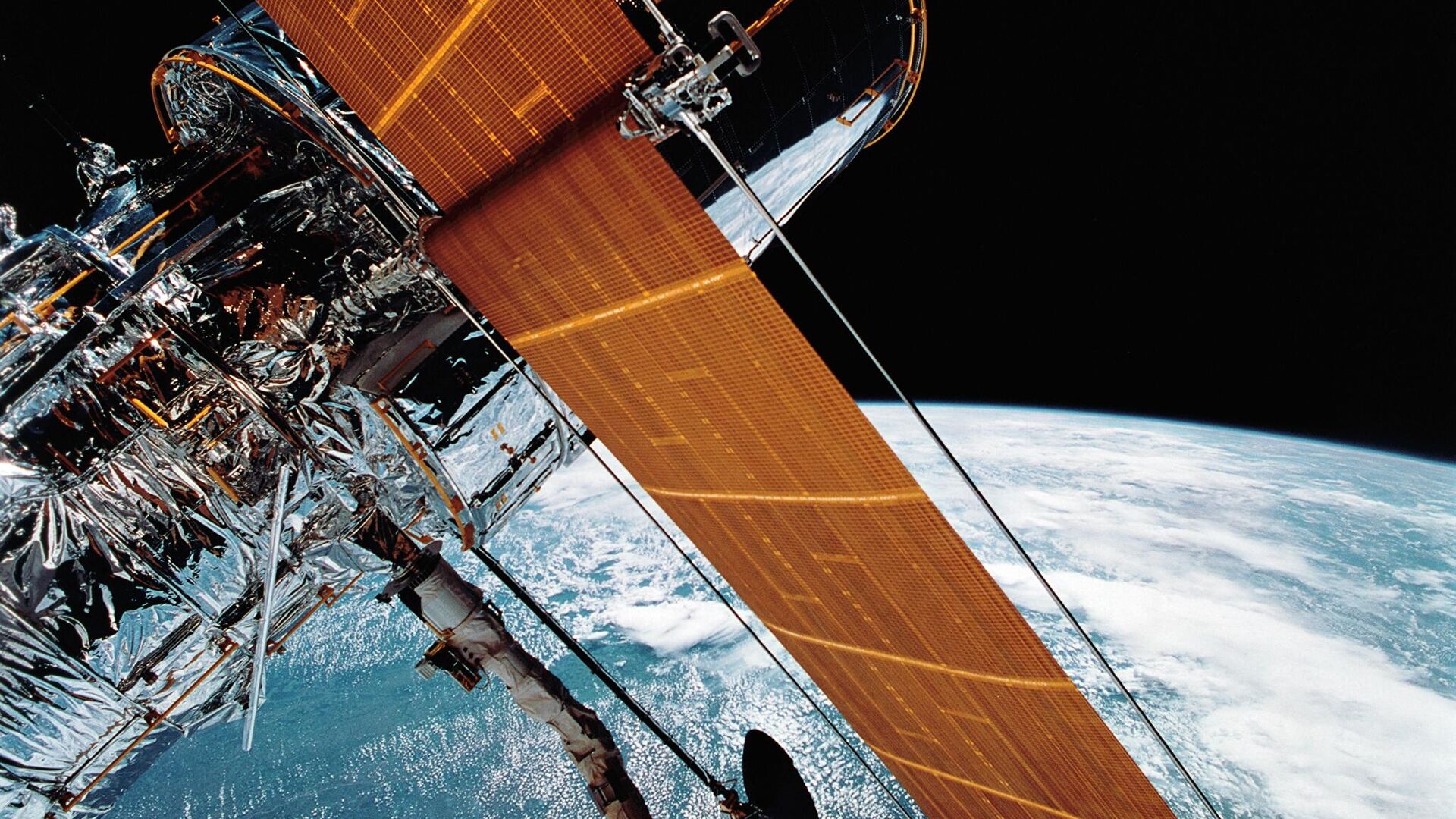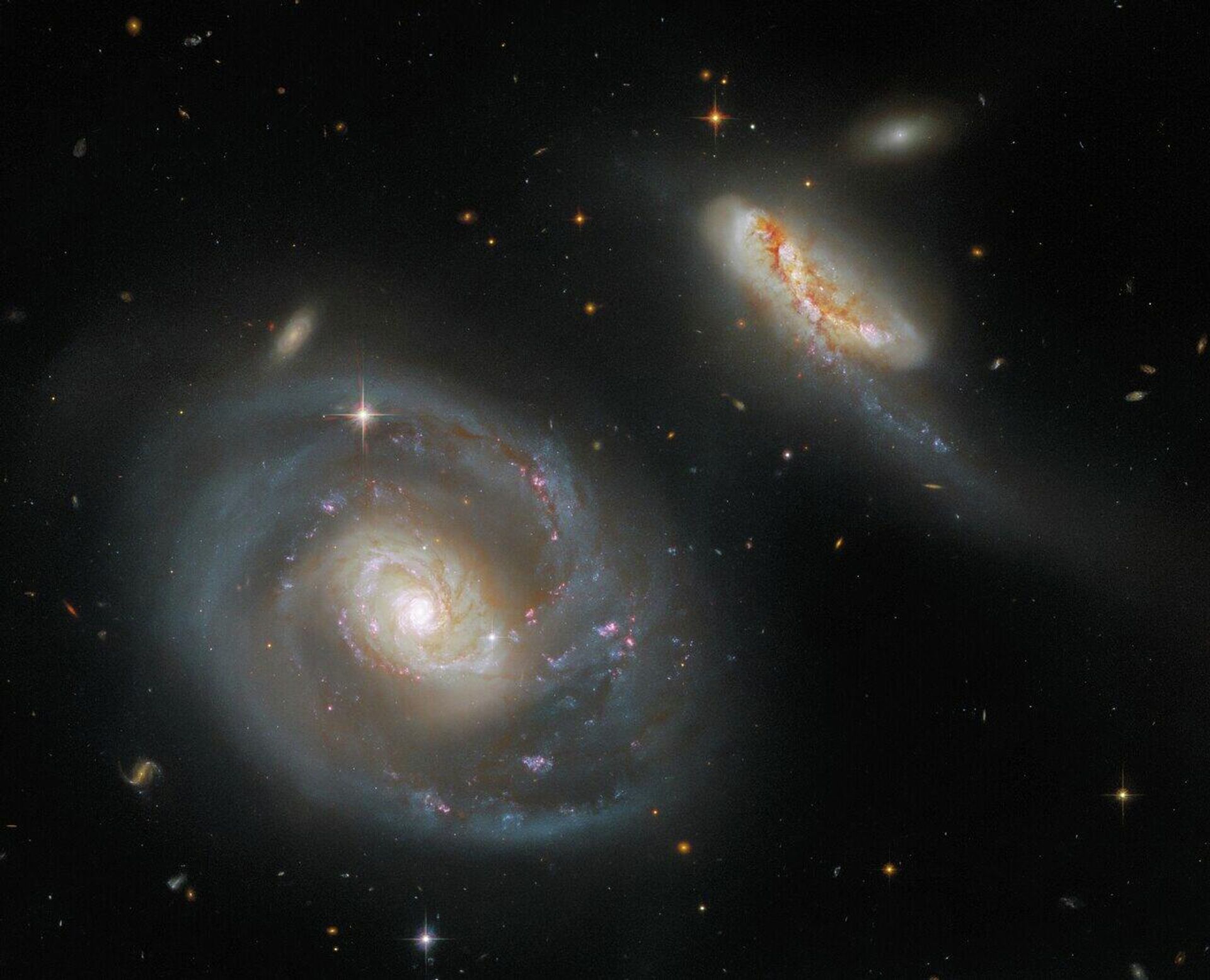https://sputnikglobe.com/20220224/photo-hubble-images-peculiar-pair-of-galaxies-in-prep-mission-for-new-webb-telescope-1093349018.html
Photo: Hubble Images ‘Peculiar’ Pair of Galaxies in Prep Mission for New Webb Telescope
Photo: Hubble Images ‘Peculiar’ Pair of Galaxies in Prep Mission for New Webb Telescope
Sputnik International
Much has been made of comparing the capabilities of the Hubble and James Webb space telescopes, but the two satellites are also working together to peer into... 24.02.2022, Sputnik International
2022-02-24T22:24+0000
2022-02-24T22:24+0000
2022-02-24T22:26+0000
hubble space telescope
galaxies
james webb space telescope
astronomy
nasa
european space agency (esa)
https://cdn1.img.sputnikglobe.com/img/07e5/0c/09/1091379120_0:448:2049:1600_1920x0_80_0_0_b731d768e0558571a1b6ee7bd29234ec.jpg
A new composite image of two galaxies was released by the European Space Agency (ESA) on Monday: the barred spiral galaxy NGC 7469 on the left and smaller IC 5283 on the right. Together, they’re known as Arp 298, a designation given them because of their interaction, which won them a spot in the Atlas of Peculiar Galaxies compiled by astronomer Halton Arp.The duo are roughly 200 million light-years away, and located in the constellation Pegasus when seen from Earth. Their tidal interaction is what has given IC 5823 a prominent tail. NGC 7469 is also an object of interest for astronomers because of the supermassive black hole at its center and because its structure is believed to be the same as the Milky Way.According to the ESA, the image is composed of a series of images taken by Hubble using its Wide Field Camera 3 and Advanced Camera for Surveys and seven different filters.The Hubble has been in space since 1990, and while NASA has launched several newer space satellites since then, they aren’t necessarily seen as replacements for the aging Hubble.“Webb will primarily look at the Universe in the infrared, while Hubble studies it primarily at optical and ultraviolet wavelengths (though it has some infrared capability),” NASA said. “Webb also has a much bigger mirror than Hubble. This larger light collecting area means that Webb can peer farther back into time than Hubble is capable of doing. Hubble is in a very close orbit around the earth, while Webb will be 1.5 million kilometers (km) away at the second Lagrange (L2) point.”According to Space.com, the Hubble’s study of Arp 298 is “scouting” for Webb, which was only launched in December and only published its first images on February 12.
Sputnik International
feedback@sputniknews.com
+74956456601
MIA „Rossiya Segodnya“
2022
News
en_EN
Sputnik International
feedback@sputniknews.com
+74956456601
MIA „Rossiya Segodnya“
Sputnik International
feedback@sputniknews.com
+74956456601
MIA „Rossiya Segodnya“
hubble space telescope, galaxies, james webb space telescope, astronomy, nasa, european space agency (esa)
hubble space telescope, galaxies, james webb space telescope, astronomy, nasa, european space agency (esa)
Photo: Hubble Images ‘Peculiar’ Pair of Galaxies in Prep Mission for New Webb Telescope
22:24 GMT 24.02.2022 (Updated: 22:26 GMT 24.02.2022) Much has been made of comparing the capabilities of the Hubble and James Webb space telescopes, but the two satellites are also working together to peer into deep space.
A new composite image of two galaxies was released by the European Space Agency (ESA) on Monday: the barred spiral galaxy NGC 7469 on the left and smaller IC 5283 on the right. Together, they’re known as Arp 298, a designation given them because of their interaction, which won them a spot in the
Atlas of Peculiar Galaxies compiled by astronomer Halton Arp.
The duo are roughly 200 million light-years away, and located in the constellation Pegasus when seen from Earth. Their tidal interaction is what has given IC 5823 a prominent tail. NGC 7469 is also an object of interest for astronomers because of the
supermassive black hole at its center and because its structure is believed to be the same as the Milky Way.
According to the ESA, the image is composed of a series of images taken by Hubble using its Wide Field Camera 3 and Advanced Camera for Surveys and seven different filters.
The Hubble has been in space since 1990, and while NASA has launched several newer space satellites since then, they aren’t necessarily seen as replacements for the aging Hubble.
“We prefer to call it a successor,” NASA says on the
Webb telescope’s page, noting that the two telescopes have different capabilities.
“Webb will primarily look at the Universe in the infrared, while Hubble studies it primarily at optical and ultraviolet wavelengths (though it has some infrared capability),” NASA said. “Webb also has a much bigger mirror than Hubble. This larger light collecting area means that Webb can peer farther back into time than Hubble is capable of doing. Hubble is in a very close orbit around the earth, while Webb will be 1.5 million kilometers (km) away at the second Lagrange (L2) point.”
According to Space.com, the Hubble’s study of Arp 298 is “scouting” for Webb, which was only
launched in December and only
published its first images on February 12.


